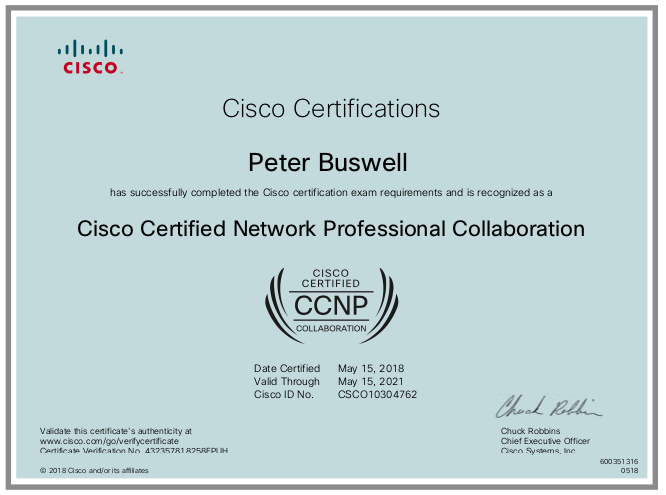[breadcrumb]
OverView of 300-075 Content
Like many other working VoIP Engineers, I have had to upgrade my CCNP yet again. The first time was when CISCO changed from CCVP to CCNP Voice. Now we have to convert from CCNP Voice to CCNP Collaboration. The good news is, if you have a CCNP voice you only need to pass this one test, the CISCO 300-075 CIPTV2! The test however, is remarkably difficult as the availability of study materials is limited. The available CISCO Press book "Implementing IP Telephony and Video Foundation Learning Guide" is just not going to get the job done! Certainly you should digest the book but do not expect to pass this exam with only the material contained in that book. The book is useful for at least highlighting the areas you need to study: (a) Expressway Firewall Traversal Configuration; (b) VCS Control; (c) All things Mobility (Device Mobility, Extension Mobility and Mobile Voice Access); (d) SRST; (e) QOS for Video including RSVP options; (f) SAF and CCD; ILS and GDPR (g) LRG, AAR and TEHO; (h) Translation Patterns and Voice Translation Rules; All these areas were covered in the exam, so be prepared. The good news is I got an 820 when i took the test the first time. The bad news is that passing was 860! There was once question on Call Clearing codes that I had not idea how it got in this test, but none the less you might want to review that material in the referenced URL300-075 Practice Tests and Dumps
If you are just looking for a cheat sheet, I really cant help you as most of the stuff on the Internet is riddled with errors. As near as I can figure it, all the practice tests and dumps on the net have the same source and are packed for marketing under different names. I do find that they are useful for getting some focus on the exam content, but you need to look up every question and find a reference that supports the answer the dump indicates is correct. I found many errors through study and research! At the end of the day, you either know this stuff or your do not know this stuff. Here is a list of sites that have practice materials available for no charge: https://www.prepaway.com/cisco/test-king.300-075.25738.ete.file.html http://vceguide.com/which-three-devices-support-the-saf-call-control-discovery-protocol/ https://www.briefmenow.org/cisco/which-three-devices-support-the-saf-call-control-discovery-protocol/ http://www.aoowe.com/practice-answer-300-075-9064.html https://www.coursehero.com/file/p2scp2p/Which-Cisco-IOS-command-is-used-to-verify-that-a-SAF-Forwarder-that-is/ http://www.cisexams.com/300-075-which-three-devices-support-the-saf-call-control-discovery-protocol-choose-three http://freecram.com/question/Cisco.300-075.v2018-02-08.q150/a-voicemail-product-that-supports-only-the-g.711-codec-is-installed-in-headquarters-which-action-allows https://issuu.com/andr.eshackleford88/docs/actual_300-075_dumps_-_implementinghttps://www.gratisexam.com/cisco/300-075/Cisco.Testking.300-075.v2015-07-28.by.Larry.44q.pdfReal VoIP Engineer Study Sites
I found a few sites that are written by other engineers who are sharing their study notes as I am doing here. Both of these are excellent examples created by other Engineers who were also cramming for this test. https://italchemy.wordpress.com/2016/06/20/cipt2-300-075-exam-helpful-information/ https://smbitsolutions.wordpress.com/2012/02/24/tail-end-hop-off-teho/ https://ccieme.wordpress.com. (really great content)!DrVoIP Study Notes on 300-075
In going through all the study materials, I noted my references and I offer them up here for others who may be following this path to certification. The questions represent practice tests from the above sources in which they all had different answers to the same question. So in keeping with my commitment to actually learn and digest this material, I dug deep to find CISCO references to support the answers or to sort through the wrong answer and find the correct answer. As with all CISCO tests you need to carefully read the question and put the answers within the context of the subject they are asking about. Many times there will be two very good answers, but only one is the one CISCO wants you to select to get the points for a correct answer! 1 - The HQ Cisco Unified Communications Manager has been configured for end-to-end RSVP. The BR Cisco Unified Communications Manager has been configured for local RSVP. RSVP between the locations assigned to the IP phones and SIP trunks at each site are configured with mandatory RSVP. When a call is placed from the IP phone at HQ to the BR phone at the BR site, which statement is true?https://www.cisco.com/c/en/us/td/docs/voice_ip_comm/cucm/admin/8_6_1/ccmsys/accm-861-cm/a02rsvp.pdf End-to-End RSVP End-to-end RSVP configuration is available if the clusters are connected by a SIP trunk. End-to-end RSVP uses RSVP on the entire connection between the end points, and uses only one RSVP agent per cluster. Consider the following scenario: endpoint A — agentA — ICT1 — ICT2 — agentB — endpoint B where A specifies an endpoint in cluster 1, B specifies an endpoint in cluster 2, ICT1 and ICT2 specify the intercluster trunks within clusters 1 and 2, and the RSVP Agents associate with the respective end points. In this scenario, Cisco Unified Communications Manager establishes an end-to-end RSVP connection between agentA and agentB. Configuring End-to-End RSVP Over a SIP Trunk RSVP configuration on a SIP trunk is determined by the SIP profile that is applied to the trunk. To enable end-to-end RSVP on a SIP trunk, configure the trunk’s SIP profile as follows:- From the RSVP Over SIP drop-down list, choose E2E.
- Set the Fall back to local RSVP field to your preference.
- From the SIP Rel1XX Options drop-down list, choose an option other than Disabled.
- Any call where the VCS takes the media as well as the signaling is a traversal calland will use a traversal call license on that VCS. The following calls require the VCS to take the media, and are therefore traversal calls:
- for a VCS Control, calls to or from a traversal server (i.e. firewall traversal calls)
- for a VCS Expressway, calls to or from a traversal client (i.e. firewall traversal calls); traversal clients include other VCSs, gatekeepers, Border Controllers, or traversal-enabled endpoints
- calls that are gatewayed (interworked) between H.323 and SIP on the local VCS
- calls that are gatewayed (interworked) between IPv4 and IPv6 on the local VCS
- for VCSs with Dual Network Interfaces enabled, calls that are inbound from one LAN port and outbound on the other
- a SIP to SIP call when one of the participants is behind a NAT (unless both endpoints are using ICE for NAT traversal)
